Sayed Haider Raza

One of the most prominent painters of his generation, S. H. Raza changed the course of modernism in India. After an early stint in Bombay, with the Progressive Artists’ Group, he moved to France, where he spent the next sixty years. His strong thrust towards non-figurative art, and subsequent influences from European and American modernism, combined with Raza’s own memories and impressions of India, led him to a skilful negotiation between Indian spirituality and Western abstraction. Accompanying the exhibition at the Centre Pompidou in Paris in 2021, this catalogue presents a compelling overview of Raza’s work and the highlights of his journey.
Sayed Haider Raza

Sayed Haider Raza

Editor Ashok Vajpeyi
With contributions by Yashodhara Dalmia, Roobina Karode, Ashvin E. Rajagopalan, Homi Bhabha, Gayatri Sinha, Ashok Vajpeyi
Mapin Publishing in association with The Raza Foundation
This monograph is published in conjunction with the exhibition “S. H. Raza [1922–2016],” celebrating S.H. Raza’s centenary at the Centre Pompidou, Paris.
First published in India in 2023 by Mapin Publishing in association with The Raza Foundation
The work is published with the support of the Publication Assistance Programmes of the Institut français.
All rights reserved under international copyright conventions. No part of this book may be reproduced or transmitted in any form or by any means, electronic or mechanical, including photocopy, recording or any other information storage and retrieval system, without prior permission in writing from the publisher.
The moral rights of authors listed in the work are asserted.
ISBN: 978-93-85360-87-9 (English ed.) ISBN: 978-93-85360-91-6 (French ed.)
Administration support: Sanjiv Kumar Choube / The Raza Foundation
Mapin Publishing 706 Kaivanna, Panchvati, Ellisbridge, Ahmedabad 380006 India
T: +91 79 40 228 228 F: +91 79 40 228 201 E: mapin@mapinpub.com www.mapinpub.com
The Raza Foundation C-4/139-Safdarjung Development Area New Delhi - 110016, Delhi, India T: +91-1146526269 info@therazafoundation.org www.therazafoundation.org
The publishers are grateful to Aicon Gallery, New York, for their support towards the publication of this catalogue.
Text © The Raza Foundation Illustrations © The Raza Foundation unless noted otherwise.
English copyediting: Ateendriya Gupta, Neha Manke, Mithila Rangarajan / Mapin Editorial English to French translation: Alliance Française, Ahmedabad and Hyderabad
French copyediting: Alliance Française, Ahmedabad and Hyderabad

Design and Art Direction: Lunel Studio, Paris Production: Mapin Design Studio Printed in Italy
Captions: Page 2
Sayed Haider Raza in one of his Paris studios
Page 5
Italian Village (detail), 1953 (See p. 185)
Page 6 Haut de Cagnes (detail), 1951 (See p. 178)
Page 8 Untitled (detail), 1975 (See p. 233)
Page 11 Paysage (detail), 1960 (See p. 205, below)
Page 12 Bindu-Genèse, 1988 (See p. 245)
Page 14 Surya–Namaskar, 1993 (See p. 246)
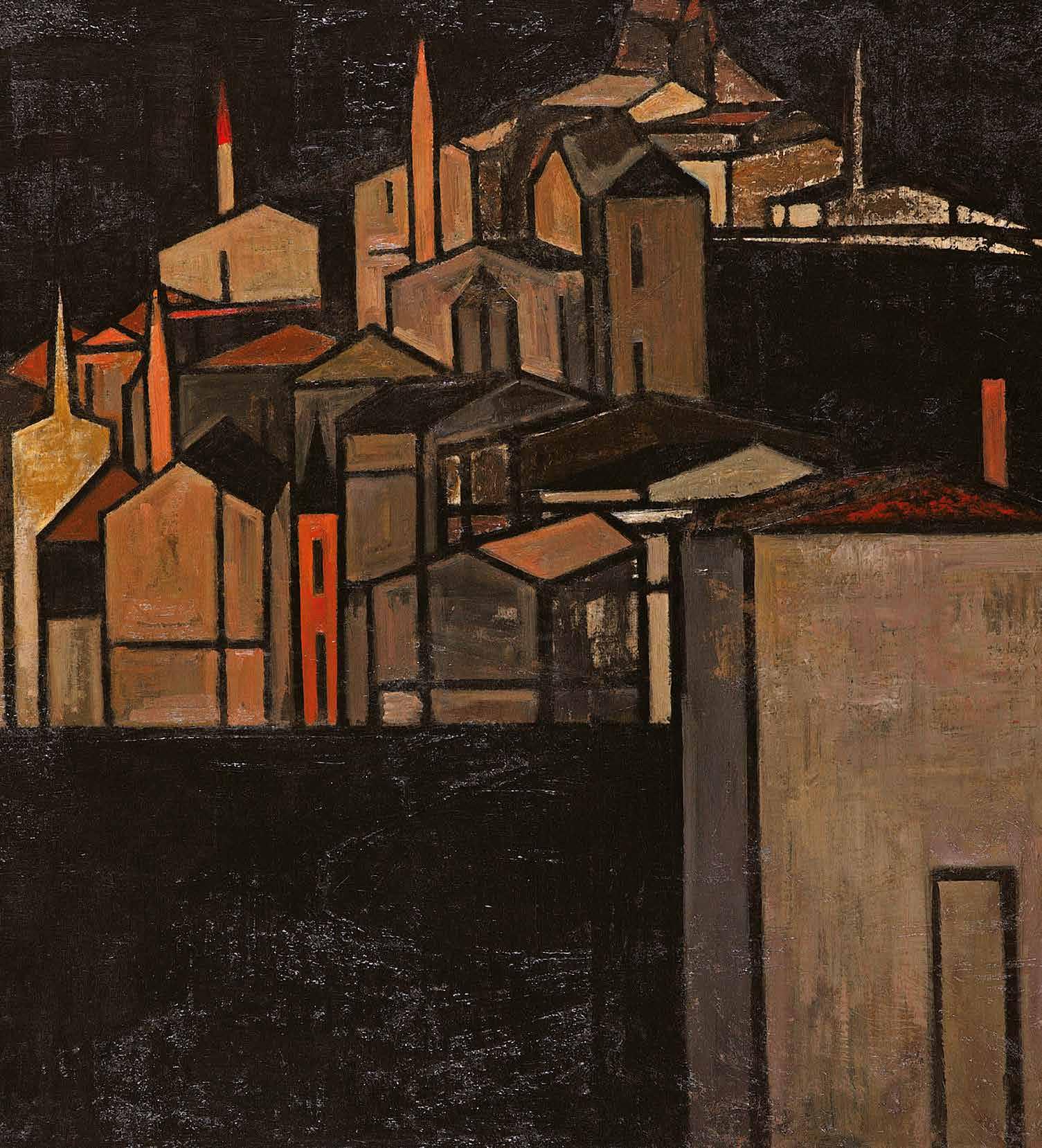

Foreword 9
Laurent Le Bon President, The Centre Pompidou
Preface 13
Ashok Vajpeyi Life and Managing Trustee, The Raza Foundation Message 15 Emmanuel Lenain Ambassador of France to India
Essays 17
Understanding
Raza on Himself
I Will Bring My Time Itinerary Seeing Beyond
From Black Sun to Bindu 19 Yashodhara Dalmia A Lesson in the Art of Contemplation 28 Roobina Karode The Experiment 40 Ashvin E. Rajagopalan Coming Back to Land: Raza’s Nostos 54 Homi Bhabha Canvas/Bhu: Ground as Visitation in Raza’s Painting 66 Gayatri Sinha In the Hundredth Year 70 Ashok Vajpeyi
Raza 81
83
Others on Raza 103
The Catalogue 161 A-Graphy by OsianamaWorld 249 Integrated Timeline Select Bibliography Exhibitions: Solo & Group Awards and Select Public Collections Appendices 283 Acknowledgements 285 The Centre Pompidou 287 The Raza Foundation 289 The Last Days 293 Raza Shati 296 Contents
Waldemar George Rudolf von Leyden Richard Bartholomew Jacques Lassaigne Paul Gauthier Pierre Gaudibert Geeti Sen Michel Imbert Friedhelm Mennekes Ranjit Hoskote Raza’s Notebooks 129 Letters from Artists to Raza 143 Janine and Raza 158
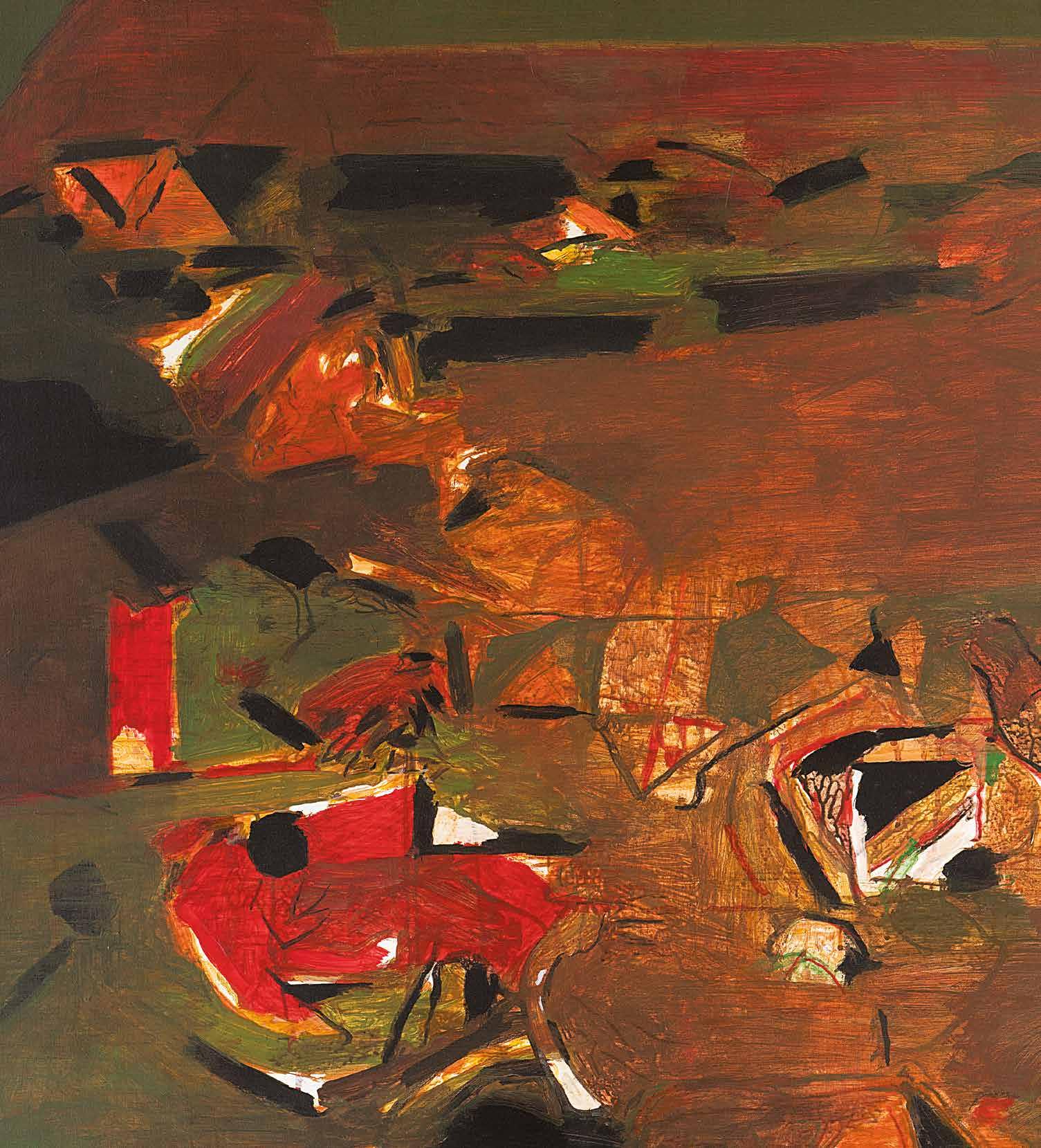
Foreword by Laurent Le Bon
Sayed Haider Raza, whose hundredth anniversary we have celebrated in both India and France, was born in 1922 in Kakaiya, in today’s Madhya Pradesh. This province is known for its historic sites and splendid forests, with which Raza, son of a forest ranger, was deeply familiar. His works, perhaps steeped in these landscapes, conjures the cultural and artistic history of India as much as the forces of nature. But Raza’s practice cannot be reduced to a rootedness in the soil of India as he spent a large part of his life in France. Living and working between Paris and Gorbio from 1950 to 2010, the artist frequently interacted with artists among the European and American avant-gardes. Hence the influences in his pictorial work from the many cultural and emotional exchanges between India and France, developing a genuine poetics of this relationship, which he cultivated through precious friendships from around the entire world. An abundant correspondence attests to this, kept in large part at the Raza Foundation in New Delhi, the artist’s last home between 2010 and 2016. Therefore, for this author of a singularly ‘other’ body of work in both India and France, Raza undoubtedly
dwelled in this “elsewhere” most of the time, and depicted it the most as well.
An early occurrence of this free circulation of forms and ideas is to be found in the 1940s and 1950s, which would be hard to qualify as years spent training, given that Raza had already demonstrated an exemplary maturity, of which his professors at the prestigious Sir J. J. School of Art in Mumbai were in agreement. At twenty-five, in 1947, he was a founding member of the Progressive Artists’ Group (PAG), along with Maqbool Fida Husain, Francis Newton Souza, Sadanand K. Bakre, Krishnaji Howlaji Ara and Hari Ambadas Gade. Although the group sought to break with the nationalist aesthetic canons of the Bengal school, which they considered too academic, the artists of the PAG, as agents of modernity, tied the group to Indian classical and folk art. Fully invested in the group’s reigning dynamics of fusional emulation, Raza took part in its experiments involving the geometrization of forms and systematically used the opaque watercolours of the ancient tradition of Southeast Asia, without ever giving up figurative work.
9
In 1950, thanks to a grant awarded by the French government, Raza came to France for the first time. In Paris, he briefly studied at the École Nationale Supérieure des Beaux-arts before being judged by his professors as too experienced to pursue learning here as well. He reconnected here with F.N. Souza and Akbar Padamsee. In 1952, they jointly presented their work at the Creuze Gallery, Raza’s first exhibition in France. Shortly thereafter, Raza met Lara Vincy, an encounter that would prove determinant because he was soon represented by her gallery. She went on to work tirelessly to raise awareness about Raza’s work, which in 1956 won the prestigious Prix de la Critique. Over the course of some fifteen years, the gallery owner and the artist kept up a daily correspondence, in which Raza indicated the details of his material life and progress with his work.
The mid-1950s marked a turning point in Raza’s practice of painting, as he abandoned gouache for oils and painted only landscapes. He was avowedly changing course towards abstraction, accumulating oils on the canvas in a manner in vogue at the time with the adepts of informal art and of the École de Paris. But the warm colours unfolding on the canvas were from elsewhere, from an ever-expanding hinterland, in tandem with his travels. In 1959, Raza married Janine Mongillat, with whom, between Gorbio and Paris, he led a life dedicated to the development of their respective practices. Henceforth, Raza’s work was focused on spiritual abstraction and was frequently likened to Mark Rothko’s art, which made quite an impression on Raza
during his sojourn in the United States in 1962. The artist drew inspiration from the forms and colours of the Rajput miniatures he was fond of to develop rigorously abstract and geometric work, in which he integrated thematic elements drawn from the singular relationship he maintained with the land, the focus of a major series of paintings. Black, deemed the “mother colour” in Indian thought, acquired a depth and a density that culminated in the systematic use, from the 1980s, of the symbol of the bindu, germ of life, the “black seed,” in his own words.
I am delighted that this first retrospective in France will be held at the Centre Pompidou with the precious support of the Raza Foundation and its president, Ashok Vajpeyi. I extend my thanks to everyone who has contributed to it, beginning with Bernard Blistène, former Director of the Musée National d’Art Moderne, assisted by Diane Toubert. It will be clear for all to see; Sayed Haider Raza is a bridge between our two countries. May the celebration of his art, in India and France, bring us closer together at a time when culture, more than ever, must be an invitation to travel and the museum a home.
Laurent Le Bon President of the Centre Pompidou, Paris
10
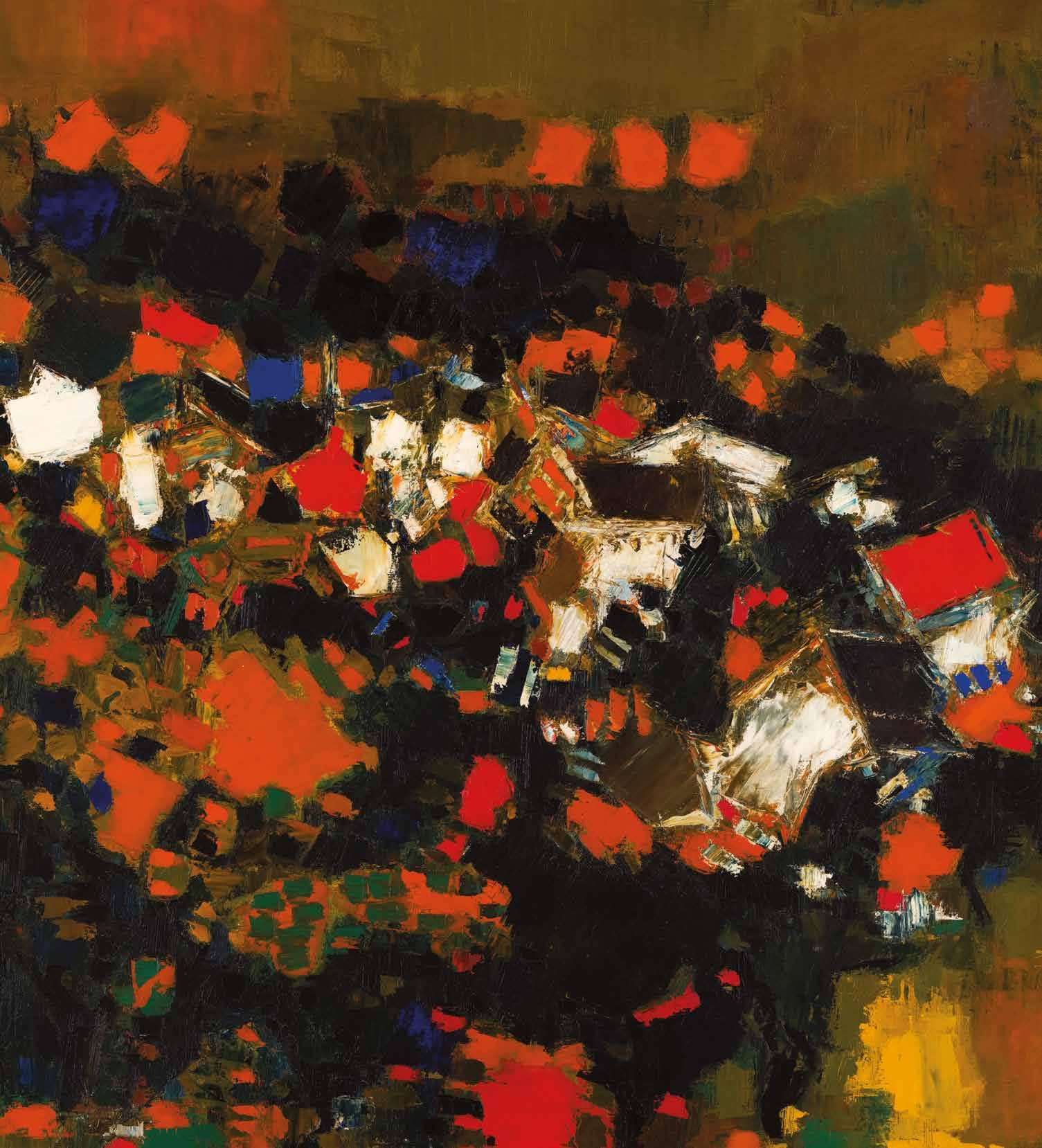

Preface by Ashok Vajpeyi
Sayed Haider Raza would have turned one-hundred years old on 22 February 2022. We are delighted to see that the most comprehensive and the largest-ever exhibition of his works is taking place in the internationally renowned and prestigious Centre Pompidou in Paris. Raza spent two-thirds of his life in Paris and Gorbio, and it is most appropriate that a show of such magnitude and magnificence take place in Paris. It hopefully would enable an international audience, despite the Covid-19 pandemic still raging, to see and appreciate a major Indian artist’s works, chosen from a wide range, executed over six decades.
The book has six specially written essays and a selection of essays or extracts written over the years by eminent critics both in India and Europe. A small selection from Raza’s own writings, his notebook and letters have also been included, besides letters from his close artist-friends. A note on his artist-wife Janine Mongillat and another on his last days in Delhi have been added to complete a comprehensive view of a very rich and inspiring life.
We are deeply honoured to have the Foreword of this publication written by the President of the Centre Pompidou, Monsieur Laurent Le Bon. A lot of effort has gone into putting together the show and this publication. We do hope that they would encourage and provoke many to view the Raza repertoire in its vast complexity and to understand how rich and varied, intense and insightful the œuvre has been. Borrowing words from Rilke, one could say: For Raza, his art has been “the small piece of pure humanity” and yet his own heart has been “too vast to be contained there.”
Ashok Vajpeyi Life and Managing Trustee The Raza Foundation, New Delhi
13

Message by Emmanuel Lenain
The Raza retrospective, presented by the Musée National d’Art Moderne at the Centre Georges Pompidou, will be celebrating in just a few months his birth centenary and paying tribute to a famous artist who has been instrumental in fostering cross-cultural influences between India and France.
Sayed Haider Raza completed his education in India at the Sir J. J. School of Fine Arts, Bombay (now Mumbai), and went on to cofound the Progressive Artists Group. Through him and his friends, this group greatly helped promote Indian art while laying the foundations of a post-Independence, contemporary art in dialogue with other cultures, which established India’s reputation. Sayed Haider Raza, active in Bombay (as it was then called) after 1947, worked extensively for this collective before choosing to trace his own artistic path.
The French part of his life started in 1950, when he was awarded a French government scholarship that enabled him to come to Paris to continue his studies at the Ecole Nationale Supérieure des Beaux-Arts. It was from this period, during which he was very prolific, that he met artists from the French and international scenes who were living in France. It was also in France that he found success. The Lara Vincy gallery, recognized for having been at the forefront of creation and for having largely contributed to writing a part of
contemporary art in our country, exhibited Raza’s works. In 1958, it was in this gallery that the artist signed his first solo exhibition. A first personal exhibition is always an important date for an artist, and the way France received Raza also highlights the friendships that have endured between him and our country. Raza obtained the Prix de la Critique in 1956, thanks to the work of gallerist Lara Vincy.
In 1959, he married French artist and sculptor Janine Mongillat, who was well-known in the Parisian scene and had affinities with India. Subsequently, Sayed Haider Raza lived for a long time in Gorbio in the Alpes-Maritimes, and, during his many decades in France, interacted with numerous artists and art scenes, particularly the European and American avant-gardes, while returning regularly to his country of origin, India. His greatly varied work reveals traces inspired by these multiple encounters and artistic discoveries.
In offering an opportunity to discover the work of Sayed Haider Raza, the Musée National d’Art Moderne has produced a very important endeavour of quest and proofing that testifies to the artist’s curiosity, his diverse and endearing elective affinities. The Raza Foundation in New Delhi—an enormous resource—has made it possible to carry out all this research, which enriches the exhibition of archives and other documents that are very useful for not
only understanding the painter’s artistic approach but also walking with him through the friendly dialogues he has had all his life with the milieus of culture around the world. The Musée National d’Art Moderne has also enriched the exhibition with an important cultural program that will provide a better understanding of the artist’s work and create links around his inspirations.
I would like to thank the Raza Foundation and its president, Mr Ashok Vajpeyi, with whom the Embassy has had friendly ties since many years now. I would also like to thank and congratulate the President of the Centre Georges Pompidou, Mr Laurent Le Bon, and Mr Bernard Blistène, former Director of the Musée National d’Art Moderne, for having organized the first retrospective of Sayed Haider Raza in France. It is a great chance to explore this major body of work in our country. I have no doubt that this remarkable exhibition will reach the widest audience, and the artist who actively contributed to building bridges between cultures and countries, Sayed Haider Raza, will be celebrated. May India and France take pride in the beautiful resonance of this event with the public, who will have the pleasure of browsing the galleries of the Musée National d’Art Moderne in Paris.
Lenain Ambassador of France to India
15
Emmanuel
Eglise Jaune, 1956 Acrylic on paper 48 × 63 cm
Courtesy: The Raza Foundation
16
Essays

From Black Sun to Bindu Yashodhara Dalmia

18
Rajasthan, 1973
Courtesy: Vadehra Art Gallery (See also, p. 228)
In wending his way through the trajectory of modernism, the artist Sayed Haider Raza moved from elementary geometrical forms to abstract shapes in light and dark and large swatches of colour enveloping the surface. At each stage, he imbued the works with his personal vision and the requisites of modernist expressions. It could be said that his quest was informed with colour and composition, which pivoted around the black circle and morphed into consistently new modalities.
Raza had spent his childhood in the forests of Madhya Pradesh, in central India, and found solace among the chlorophyllous greens of foliage and the juicy sap of plants. Seeing his innate talent to catch the quick of life, he was sent to train at the Nagpur School of Art, from where he made his way to Bombay (now Mumbai), the centre of art activity in India at that time. These were sombre times for the newly independent country, which was to experience the ravages of Partition. In the midst of the ensuing communal frenzy, Raza’s entire family left for Pakistan. Yet the artist chose to remain in Bombay, where he was a founding member of the forceful modernist group known as the Progressive Artists’ Group (PAG), formed in the very year that the country gained independence. The PAG formulated its own notions, discarding any revivalist tendency or academic naturalism in art, and in the midst of a welter of existing traditions, it carved its own path to modernism, linking it to international trends. Raza was to engage in debates and discussions with other members of the Group, such as M. F. Husain and F. N. Souza, which would
continue late into the night. Their poverty of means was matched by their sincerity and talent, which would later propel them into the mainstream of art in the country.
To acquire greater training and to acquaint himself with the works of masters such as Cézanne, Picasso and Matisse, Raza made his way to Paris in 1950 on a scholarship. In many ways this was to be a culmination as well as a beginning. Postwar Paris suffered from a sense of exhaustion and wore a haunted look. The regular meeting places of artists and writers, like Café de Flore, had a deserted air and the masters were present only by their absence. The École de Paris (School of Paris) had run its course, leaving behind the last remnants of abstract art, with painters such as Pierre Soulages, Nicolas de Staël and Serge Poliakoff. While the scene had shifted to New York, Paris, the city par excellence for art, harboured a melancholy nostalgia for the masters of art. Yet, a whole generation of artists from other parts of the world was to make their way here to imbibe the paradigms of modernism that the city had been celebrated for. Raza, for instance, engaged with the Lebanese artist Chafiq Abboud, whose journey was comparable to his, in that both artists spent most of their lives in Paris but became influential painters in their own country. Abboud also remained attached to his Middle Eastern roots, recalling his grandmother’s oral storytelling as well as the Byzantine icons in churches, which would eventually radiate in his works. His encounter with École de Paris led him to move from a Lebanese tradition of figurative and landscape painting to a colourful personal abstraction.
From Black Sun to Bindu
19
In the Hundredth Year
Ashok Vajpeyi

70
Aarambh, 2014
Acrylic on canvas, 120 × 100 cm
Courtesy: The Raza Foundation, New Delhi
When he wrote “I Will Bring My Time,” it was not an aesthetic boast but a gentle assertion that Sayed Haider Raza made in a love letter to Janine Mongillat, a French artist who became his lifecompanion in 1959. He had been in Paris for about a decade, a young struggling Indian artist who eventually remained there for six decades, the longest time any Indian artist has lived and painted in France before or after him. Raza did not change his nationality and retained his Indian passport till the end. He returned to India for good towards the end of 2010 and died on 23 July 2016 at a New Delhi hospital. He was buried, as he wanted, the next day in Mandla, next to his father’s grave, close to the river Narmada, which he always remembered with deep regard.
Having experienced beauty and fear in the thick jungles of Mandla in his childhood, the two became his life-long concerns, fear both superseded and side-lined as he pursued beauty through his art. He attained a rare but vitally creative fusion in his art, of French la sens plastique and Indian metaphysical concepts. Raza would say that he learnt how to paint from France and what to paint from India! He searched for a visual language in painting, which could enact his sense of celebration and affirmation of life as also reveal sensuously, in vibrant colours and dynamic form, his spiritual reality as it were. Living in the West for nearly six decades, Raza explored in his work an alternative modernity of consonance, celebrative and cerebral, of affirmation and silence, of germination and rejuvenation. Nature remained a central theme for him throughout his life.
It was perhaps an inherited pagan sensibility not giving in to the dichotomies that dominated modern Western art. His early French period works were largely cityscapes, and he later painted “inscapes.” He termed his art as roop adhyatam, or “spiritual form,” underlining that for art, beauty is at once both physical and metaphysical. In Raza’s paintings, there are no visible traces of the post-World War II history, although he was in France at the time. Once, when I told him that he was more concerned with eternity than history, he joyously agreed!
For a couple of decades in France, life was not easy and smooth for Raza. He was accepted as a painter of the Parisian School, which gave him some recognition and clientele, but equally, it made him unhappy about his artistic identity. It is then that he, through a lot of agonizing self-questioning, recalled bindu—an image that a primary school teacher in a village school near Mandla had told him, a boy of wayward mind, to concentrate upon. Bindu as a source of energy, a point of entry and exit and a still centre, became the central motif for Raza. In popular imagination, both among casual viewers and serious observers of art, bindu came to be identified with Raza:
“I have no apology for my repetition of the form of the bindu. With repetition, you can gain energy and intensity as is gained through Japmala, or the repetition of a word or a syllable until you achieve a state of elevated consciousness.”
In the Hundredth Year
71
 Kriti Prakriti, 2012
Kriti Prakriti, 2012
80
Courtesy: The Raza foundation, New Delhi (See p. 101)
Understanding Raza
A poem by the modernist American poet Wallace Stevens is titled “Thirteen Ways of Looking at a Blackbird.” If it be so, then there must be many more ways of looking at art. Raza wrote extensive notes about his art and vision; several critics, from France, Europe and India, wrote about his art, and throughout his life, Raza kept in touch with his artist–friends by way of letters. All this rich and varied material offers interesting insights to better understand the life, the struggles, the self-reflections, the richness of Raza.
A small selection is being presented here. Some of his own notes, a few love letters to his artist–wife Janine Mongillat, and some extracts from his notebooks are included. He kept notebooks— all called “Dhai Akshar ” (Two and a Half Letters)—in which he noted poems, thoughts, philosophical and aesthetic ideas, utterances from a wide range of sources, writers and thinkers, poets and sages in many languages, namely Hindi, Sanskrit, French, English and Urdu.
The essays or extracts from the critics have been selected keeping in mind both their historical and continuing relevance, providing a critical map of the artistic journey of more than 70 years. A. V.
81
Encounter, 1999 Courtesy: The Raza foundation, New Delhi (See, p. 99)
Raza on Himself

I Will Bring My Time: Love Letters from Raza to Janine Mongillat, 1953–54
These are some of the letters by Raza we found among the material that he brought with him when he moved from Paris to Delhi in 2011. The fifty-odd letters to Janine Mongillat, whom he married in 1959 after almost a decade-long courtship, were found, with very few by Janine. He was an avid letter writer and spent a long time framing his letters. These love letters are no exception.
Apart from revealing a depth of emotion, of longing and desire, these letters also reveal an aspect of Raza hardly noticed before. He effortlessly revealed his knowledge of writers such as Paul Valery, Charles Baudelaire, Andre Gide, and so on, by quoting from them. He also articulated, in depth, an expansiveness in his ideas about life, art, time, and worldly circumstances in his letters, to someone he loved, and who was to become his life-companion. A small selection is being presented here. A. V.
84
Others on Raza

Ranjit Hoskote
Ranjit Hoskote is a cultural theorist, curator and poet. He is the author of more than 25 books and two collections of poetry.
Over the seven decades of his practice, S.H. Raza became an indispensable cartographer of lost continents of meaning, a bridge-maker who recalls us to an awareness of those devices of sensuous knowledge, and of gnosis, that some have perhaps been too eager to abandon to the museum of superseded ideas. Raza was also a pilgrim in the realms of philosophy and poetics: through his paintings, he tested out various propositions concerning the relationships between image and resonance, poetry and abstraction, colour and memory.
We may discern the unfolding inner logic of Raza’s practice in the transition that he made from the formally accomplished Kashmir landscapes and French townscapes, produced in the first phase of his career, to the vital and pulsating symbolism that eventually came to distinguish the art of his maturity, its lavish chromatic and textural sensuality engaged in productive interplay by an austere geometry signalling to the forms of cosmography. In Raza’s paintings, the eye dwells on a series of concentric circles that build into mandalas; on the double helix, which signifies both the closely intertwined serpents of India’s chthonic fertility religions and the abiding symbol of the human DNA; on the cobalt flow of the river, laid against the umbers and sienna of the terraced and furrowed earth; and on the rising arrow of stacked herringbones, marking the symbiosis and synergy linking earth, prithvi, with the empyrean, akasha.
Raza did not simply relay a received trove of symbolism into the present. Rather, he created symbols that carry us across the disruptions of contemporary living, towards an appreciation of the contemplative continuities that can restore us to wholeness. Constantly, he refashioned for us archetypal reminders of our relationship to the larger framing contexts of our lives, presenting us with evocations of the life-force and the elements from which it gathers dynamic impetus—of time and of eternity.
Raza’s paintings are dramatic foci, intended to heal our fragmented attention and our broken faculties of cognition, and endow them with coherence. Regarded in this light, his works are charged with the power of the threshold, crossing which, we enter a space of dream and transformation. The paintings are not subject to the rise and fall of fashions; their relevance lies not in what they are, but in what they do. At their best, Raza’s paintings are not nouns that burden memory; they are verbs that act directly and palpably on the viewing consciousness.
This text was previously published in Ashok Vajpeyi (ed.), Understanding Raza: Many Ways of Looking at a Master, New Delhi: Vadehra Art Gallery, 2013.
—
128
Raza’s Notebooks


Raza's Notebooks 130


Raza's Notebooks 131
Janine and Raza

Janine and Raza
Raza met Janine Mongillat at the art school in Paris, where he was studying on a scholarship from the French government. After nearly a decade-long courtship, the two got married in 1959.

Janine was, compared to Raza, a more experimental artist who used a lot of unusual materials to create art, including tea-bags, wooden toys from Benaras, almirahs and throw-away objects. Raza admitted that he came to understand some of the metaphysical aspects of Christianity through her. Raza used to visit the church where Janine was baptized, close to the Rue de Charonne, every Sunday, and they visited India many times together.
Janine took part in many salons in Paris, and her solo shows took place in Paris, Berkeley, Milan, Grenoble, Menton, Saint-Remyde-Provence. They worked in separate studios, both in Paris and Gorbio. They were deeply involved in the restoration of the twelfth-century chateau in Gorbio and its conversion into an arts centre, and gifted several of their works as well other artists’ from their collection to the centre.
Janine was greatly admired among friends for her frankness, generosity, artistic views that were quite different from those of Raza as well as her enthusiastic hospitality. She was Raza’s true life companion. Janine passed away in 2002.

159
La Terre (detail), 1977
Courtesy: Kiran Nadar Museum of Art, New Delhi (See, p. 235)
160
The Catalogue

 Village Corse, 1957 Oil on canvas, 80 × 160 cm
Village Corse, 1957 Oil on canvas, 80 × 160 cm
198
Courtesy: Musée d'ethnographie de Genève, Johnathan Watts

199
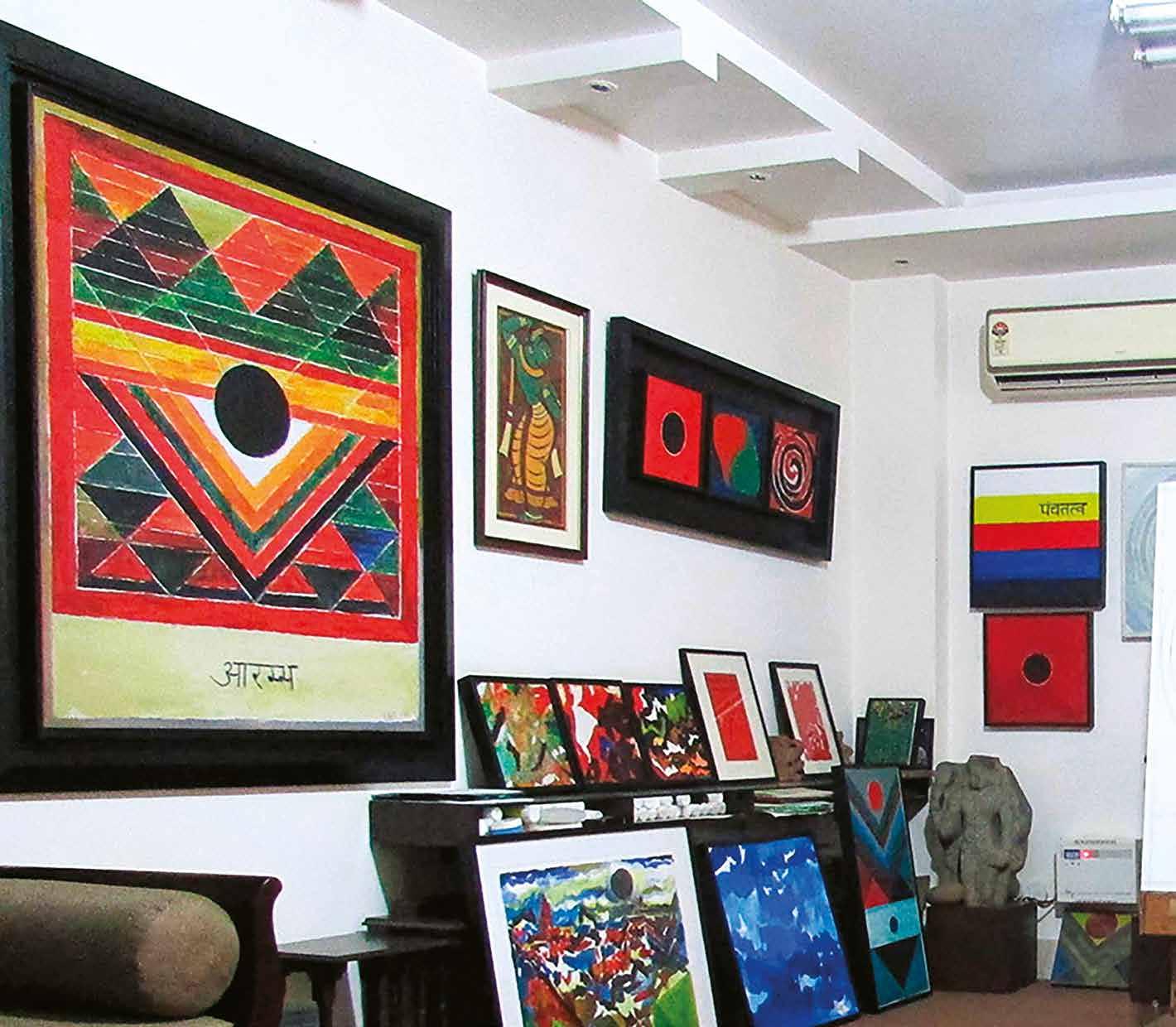 Raza’s last studio, 2011–16, New Delhi
Raza’s last studio, 2011–16, New Delhi
294
Courtesy: The Raza Foundation, New Delhi
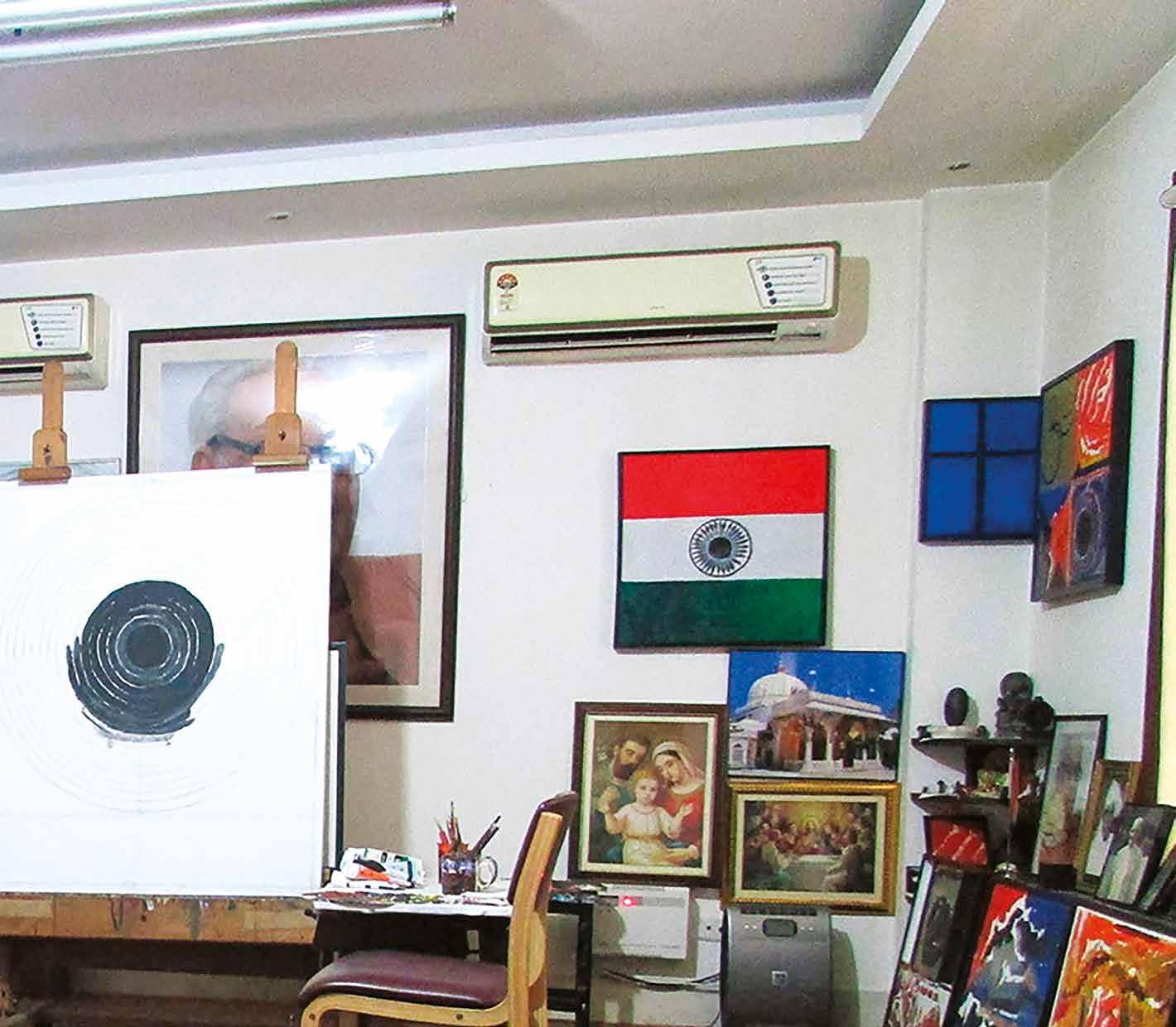
295
Yashodhara Dalmia is an independent art historian and curator based in New Delhi. Roobina Karode is Director and Chief Curator, Kiran Nadar Museum of Art. Ashvin E. Rajagopalan is an art historian and the Director of the Piramal Museum of Art, Mumbai. Homi K.Bhabha is the Anne F. Rothenberg Professor of the Humanities, Director of the Mahindra Humanities Centre, and Senior Advisor to the President and Provost at Harvard University. Gayatri Sinha is a critic, editor and curator and has curated many important shows and written extensively about modern and contemporary Indian art. Ashok Vajpeyi is a New Delhi-based Hindi poet-critic who has written poetry and criticism of literature, music and visual arts in many publications.
Editedby Ashok Vajpeyi
MODERN & CONTEMPORARY ART Sayed Haider Raza
296 pages 298 illustrations 10 x 11” (254 x 280 mm), hc ISBN: 978-93-85360-87-9 ₹3500 | $60 | £49 Feb. 2023 | World rights
One of the most prominent painters of his generation, S. H. Raza changed the course of modernism in India. After an early stint in Bombay, with the Progressive Artists’ Group, he moved to France, where he spent the next sixty years. His strong thrust towards non-figurative art, and subsequent influences from European and American modernism, combined with Raza’s own memories and impressions of India, led him to a skilful negotiation between Indian spirituality and Western abstraction. Accompanying the exhibition at the Centre Pompidou in Paris in 2023, this monograph presents a compelling overview of Raza’s work and the highlights of his journey.
















 Kriti Prakriti, 2012
Kriti Prakriti, 2012










 Village Corse, 1957 Oil on canvas, 80 × 160 cm
Village Corse, 1957 Oil on canvas, 80 × 160 cm

 Raza’s last studio, 2011–16, New Delhi
Raza’s last studio, 2011–16, New Delhi



